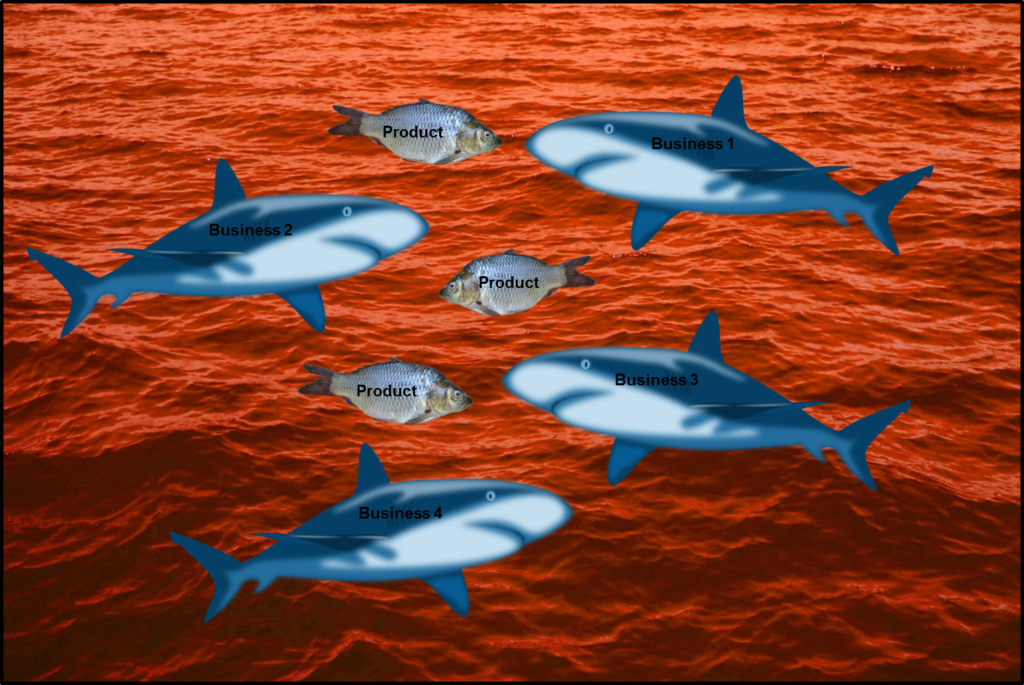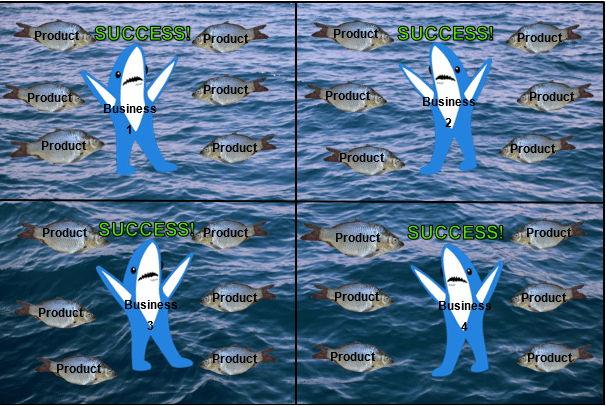Blue Ocean vs. Red Ocean strategy: how to create an uncontested market space and avoid shark infested waters
Management strategy is an integral part of the success of a business and often determines whether the business will rise or fall within its market space. This also holds for IT strategy. The most common management strategy seen in many corporate settings today involves a military-like approach whereby rivals compete with one another for their customers and for a greater share of the already existing demand. This strategy – referred to as the Red ocean – relies upon the societal defined boundaries of industry, confining corporations within these boundaries causing an increase in the rivalry and turning business strategy into a bloodthirsty, military-like war that is waged against one’s rival company. Naturally, this is not conducive to high performance functioning of a business and is certainly not sustainable. To better understand this concept, let’s use the analogy of shark-infested waters.
Referring to the image below, when too many sharks are pooled together in the same area, each shark will have to compete to get its share of the fish it needs to eat. Too many sharks are present in the water, and there are simply not enough fish to satisfy them. Nature takes its course as the sharks begin competing with each other over the fish, turning the water bloody and red i.e. creating a Red ocean. None of the sharks will receive a share of fish that they deem satisfying, and an unsustainable, low-performance environment will be created in which competition never ceases and the sharks never reach full satisfaction.

The same logic is applied to businesses that incorporate this strategy into their management tactics. They are confined within their previously defined and accepted boundaries, causing overcrowding and making the product a commodity to be fought over. This war-like rivalry creates a management strategy that focuses primarily on how to one-up one’s rival to receive a greater share of the product/demand rather than on how to create a high performance and, therefore, sustainable business environment. This unconscious shift in focus perpetuates rivalry, thus, never really providing the business with the share of the demand that it needs to be truly successful. Solving this strategic problem involves changing strategy altogether, focusing on creating demand rather than fighting for it. This solution strategy necessitates a calmer Blue ocean.
Blue ocean involves a strategy that moves away from military-like strategy to shift focus in order create an environment in which businesses create the demand that they need. This decreases the need for competition and rivalry, ensuring that a high performance environment is sustained in order to benefit the business and contribute towards it success.
This is described using our shark analogy in the image below. In this image we can see that each shark has been separated into its own environment away from the other sharks. This allows each shark to hunt for fish without the hindrances associated with competition and rivalry seen in the previous image. The spaces remain under-crowded meaning that the fish do not become a precious commodity to be fought over by numerous sharks. Each shark, therefore, has its own endless supply of fish and no bloodthirsty competition is required i.e. the ocean does not turn red, but remains Blue.

Once again, the same can be applied to businesses and their strategy. If businesses focus on implementing strategies that involve creating the demand that they need rather than fighting for it, they ensure that their market space remains uncontested meaning that, essentially, all the demand and product available is theirs for the taking because they have created it. This form of strategic business management focuses on pushing for high performance business functioning to create a sustainable environment in which the business can grow its market and its brand. This environment is supplied by the Blue ocean.
| Red ocean strategy | Blue ocean strategy |
| Compete in defined boundaries within existing market space. | Create uncontested market space. |
| Beat the competition. | Ensure that the competition becomes irrelevant. |
| Exploit existing demand. | Create and capture new demand. |
| Make the value/cost trade-off. | Break the value/cost trade-off. |
| Align the whole system of a company’s activities with its strategic choice of differentiation OR low cost. | Align the whole system of a company’s activities in pursuit of differentiation AND low cost. |
Table 1 from Kim and Mauborgne's Blue Ocean Strategy (October 2004), Harvard Business Review
The above table clearly outlines the differences in goals for the Red ocean and Blue ocean strategies. The goals are unambiguously different from one another, with Blue ocean shifting focus from the competitive and exploitative structure of Red ocean to an uncontested, high-performance environment in which the rival becomes irrelevant.
In order to make a successful shift from Red ocean to Blue ocean strategy, business must change their units of analysis from the traditional, widely accepted “company and industry” units to units that include the organisation’s value drivers as their defined metric. This ensures that strategies based on this metric include an approach that favours a Blue ocean strategy and does remain confined to the modern company and industry boundaries.
The Balanced Scorecard
The Balanced Scorecard is another tool to map and measure strategy and the execution thereof.

Illustrated above is a balanced scorecard in which a well-rounded view of the business and its goals can be entered to ensure that every management strategy implemented is one that supports the business’ vision and focuses on high-performance, sustainable business management.
The balanced scorecard ensures that perspective focusing on the customer, the commercials, the internal processes and the growth and learning of the employees are taken into account. This ensures that there is a balance between all the different concerns and stakeholders. The TNT case study is a great example showing how to bring all of this together.
Reflection
The most common business strategies seen today in many business do not create or sustain a high-performance environment due to the employment of the Red ocean strategy, resulting in intense competition and scarce demand. This strategy is employed because of the boundaries set in which business and organisations become confined, often having no choice but to compete against each other and form rivalries. In order shift from this strategy, a strategy that promotes the creation of demand and disposes of unnecessary competition must be implemented. This is the Blue ocean strategy. This will allow the business to create its own demand and render its competition irrelevant, creating a high-performance and sustainable environment that is free from bloody waters and shark infestation. The balanced scorecard is a great tool to capture and measure the execution of the chosen strategy.
Resources
Kim, W., & Mauborgne, R. (2004). Blue Ocean Strategy. Harvard Business Review, 76-84.
Competition is for losers by Peter Thiel
The TNT case study
What is next
Previous Post |
Next post |
The IT - Business Partnership |
Role of the CIO |
For all our Modern IT Management Lectures.
For all our Podcasts.
